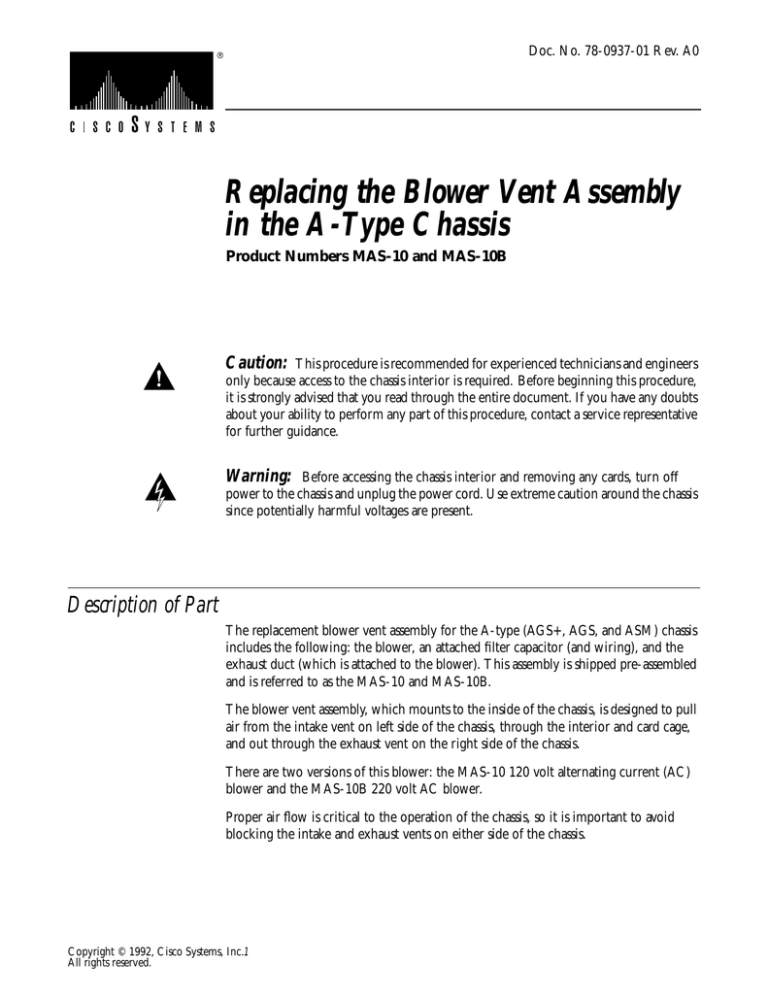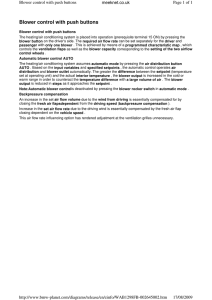
Doc. No. 78-0937-01 Rev. A0
Replacing the Blower Vent Assembly
in the A-Type Chassis
Product Numbers MAS-10 and MAS-10B
Caution:
This procedure is recommended for experienced technicians and engineers
only because access to the chassis interior is required. Before beginning this procedure,
it is strongly advised that you read through the entire document. If you have any doubts
about your ability to perform any part of this procedure, contact a service representative
for further guidance.
Warning:
Before accessing the chassis interior and removing any cards, turn off
power to the chassis and unplug the power cord. Use extreme caution around the chassis
since potentially harmful voltages are present.
Description of Part
The replacement blower vent assembly for the A-type (AGS+, AGS, and ASM) chassis
includes the following: the blower, an attached filter capacitor (and wiring), and the
exhaust duct (which is attached to the blower). This assembly is shipped pre-assembled
and is referred to as the MAS-10 and MAS-10B.
The blower vent assembly, which mounts to the inside of the chassis, is designed to pull
air from the intake vent on left side of the chassis, through the interior and card cage,
and out through the exhaust vent on the right side of the chassis.
There are two versions of this blower: the MAS-10 120 volt alternating current (AC)
blower and the MAS-10B 220 volt AC blower.
Proper air flow is critical to the operation of the chassis, so it is important to avoid
blocking the intake and exhaust vents on either side of the chassis.
Copyright © 1992, Cisco Systems, Inc.1
All rights reserved.
Preventing Electrostatic Discharge (ESD) Damage
Electrostatic discharge damage (ESD) occurs when electronic printed circuit cards are
improperly handled and can result in complete or intermittent failures. ESD can impair
electronic circuitry and equipment. Follow ESD prevention procedures when removing
and replacing cards.
Following are steps for handling printed circuit cards:
Step 1:
Slip on an ESD wrist strap, ensuring that it makes good skin contact.
Step 2:
Connect the strap to an unpainted chassis frame surface or another proper
grounding point or surface to safely channel unwanted ESD voltages to
ground (see Figure 1).
Figure 1
Placement of ESD Wrist Strap
Step 3:
Use the ejectors to remove the card. Handle the card by its sides. Place the
card on an antistatic surface or in a static shielding bag. To prevent further
damage to the card by ESD voltages, defective cards must remain in the static
shielding bag when returned for repair or replacement.
Step 4:
Handling the new card by its edges only, insert it into the chassis. Avoid
contact between the card and clothing. The wrist strap only protects the card
from ESD voltages on the body; ESD voltages on clothing can still damage
the card.
Use an ohmmeter to check the ESD wrist strap to ensure that the resistor is providing
proper ESD protection. For safety, the measurement should be in the range of 1 to 10
Mohms.
2Replacing
the Blower Vent Assembly in the A-Type Chassis
Blower Vent Assembly Replacement Procedures
Following are the procedures for replacing the MAS-10 and 10B blower vent assembly
in the A-type chassis:
Note:
Before installing this assembly, be sure to read through this entire document for
complete installation instructions. Remove the chassis from any rack-mounts before
beginning these procedures.
Tools Required
The following tools are required for this procedure:
■
Two Phillips screwdrivers, sizes No. 1 and No. 2
■
5/16'' nut driver or a medium adjustable wrench
■
Ten mounting screws from the old assembly
Warning:
Before accessing the chassis interior, turn off power to the chassis and
unplug the power cord because high voltages may exist in or near the power supply. Use
extreme caution when working near the power supply. Attach appropriate ESD
protection before beginning the replacement procedure.
Accessing the Chassis Interior
Following is the procedure for accessing the chassis interior:
Step 1:
Power the chassis down and unplug it from AC power.
Step 2:
Disconnect all external cables from the chassis back panel. Note where these
cables were connected for reinstallation.
Step 3:
If the chassis is rack mounted, remove it from the rack and transfer it to a
desktop or work table.
Step 4:
Loosen the two thumb fasteners and remove the front access panel from the
chassis (see Figure 2).
Step 5:
Locate and remove the seven No. 1 Phillips screws securing the top of the
chassis (see Figure 2. Set the top and screws aside.
Replacing the Blower Vent Assembly in the A-Type Chassis 3
H1096a
Cover screws (7)
Thumbscrews (2)
cisco Systems
AGS+
Access panel
Figure 2
The Front and Top Panels on the A-Type Chassis
Step 6:
Locate and remove the flat 50-pin console cable which runs from the front of
the processor card (first or second card from the top slot) to the rear of the
chassis interior. This flat cable rests on top of the card cage and blower vent
assembly.
Step 7:
Drape the loose end of the console cable over the rear of the chassis.
Removing the Suspect Blower Vent Assembly
Following is the procedure for removing the blower vent assembly:
4Replacing
Step 1:
Locate and remove the blower vent assembly by unscrewing the ten No. 1
Phillips screws that secure the assembly to the chassis. Remove the lower
screws first and the top-center screw last. These screws are located around the
exhaust vent toward the rear of the chassis’ right side (as viewed from the front
of the unit).
Step 2:
Locate the plastic cable clamp that sits near the center of the floor of the
chassis and use the 5/16'' nut driver to remove the nut that holds the cable
clamp in place. Set the clamp and nut aside. The cable clamp holds two sets
of wires: one set connects near the cable clamp, and the other set connects to
the AC switch housing (located beneath the blower vent assembly).
the Blower Vent Assembly in the A-Type Chassis
Note:
If access to the cable clamp is blocked by an applique card cage in the rear
center plate position, remove the applique card cage. Approach the rear center plate from
the outside rear of the chassis and remove the six No.1 Phillips screws that hold the plate
in place. Drape the plate and appliques over the front of the unit and set the screws aside.
Step 3:
Unplug the set of wires (attached to the blower vent assembly) whose
connector is nearest the cable clamp.
Step 4:
Completely remove the suspect blower vent assembly and set it well away
from the chassis.
Verifying the Blower Vent Assembly Operating Voltage
There are two types of blower vent assemblies available: the MAS-10 and the MAS-10B.
The MAS-10 operates at 120 volts AC, while the MAS-10B operates at 220 volts AC.
Warning:
The AC operating voltage of the blower must be equal to the AC source voltage
supplied to the chassis. If the AC source voltage is too high, the blower will be damaged
and could result in fire. If the AC source voltage is too low, the blower will not operate
correctly (too slowly) and the chassis will overheat. A MAS-10 blower rated at 120 volts
should only be connected to a 120 volt AC source. A MAS-10B blower rated at 220
volts should only be connected to a 220 volt AC source.
Following are the distinguishing characteristics of each blower vent assembly:
■
The MAS-10 and MAS-10B are shipped with an attached orange label indicating
the operating voltage (120V or 220V respectively). This label will be placed on the
duct or the blower.
■
The physical size of the cylindrical filter capacitor (which is mounted on the blower
vent assembly) is smaller for the MAS-10B. The height and diameter of the capacitor
are 3.5'' and 1.25'' for the MAS-10, and 2.5'' and 1'' for the MAS-10B. If you are
uncertain, measure the filter capacitor on the assembly you received.
■
A manufacturer’s label is on the blower itself. This label indicates the operating
voltage of the blower (120V or 220V).
Note:
Compare the operating voltages of the blower vent assembly you received and
the AC source to which this assembly will be connected. Check the blower interior for
loose material that could affect the operation.
Replacing the Blower Vent Assembly in the A-Type Chassis 5
Installing the New Blower Vent Assembly
Following is the procedure for installing the new blower vent assembly in the chassis:
Step 1:
Position the new blower vent assembly (approximately) within the chassis
opening, with the opening of the vent duct facing the right side of the chassis.
Do not attach the assembly to the chassis at this time.
Step 2:
Reach into the chassis (around and beneath the blower vent assembly) and
connect the blower plug and socket nearest the cable clamp post (this was
disconnected when you removed the old blower vent assembly).
Step 3:
Bundle the blower wires with the other wires previously held by the cable
clamp and use the 5/16'' nut driver to reattach the cable clamp to the bolt
near the center of the chassis floor.
Step 4:
Attach the blower vent assembly to the chassis starting with the top-center
No. 1 Phillips screw (do not tighten any screws until all ten screws are in
position and the assembly is aligned).
Step 5:
Connect the console cable to the processor card (the first or second card from
the top in the AGS and ASM card cage; the second card from the top in the
AGS+ card cage) and carefully flatten the console cable over the top of the
blower vent assembly and card cage.
Caution:
Only attach the console cable to the 50-pin connector on the processor
card to prevent damage to the system.
Testing the Installation
Connect the power cable and power on the chassis. If the blower is installed correctly, it
will come on immediately. The blower is somewhat noisy (approximately 60 Decibels),
but there should be no other noise associated with the correct function of the blower. If
you hear other noises, check for loose screws where the duct attaches to the chassis wall.
After successfully testing the installation, assemble the chassis by replacing the chassis top
and the seven No. 1 Phillips screws.
The system is ready to be installed in the network.
6Replacing
the Blower Vent Assembly in the A-Type Chassis



